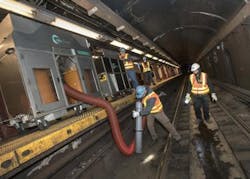MTA Testing Prototypes of New Portable Vacuum Systems to Support Effort to Keep Tracks Clean
“Testing these new technologies is a key part in our plan to get the tracks cleaner, and keep them cleaner over the long haul,” said MTA New York City Transit President Veronique Hakim. “Once we’re sure that these units are effective we’ll be ordering additional units to deploy across the system.”
The first unit is currently being tested, while the second will be deployed within the next two weeks. The prototype units are both powered by lithium iron phosphate batteries with a battery management system that protects the batteries and load from over current, and both can be moved from station to station on a conventional revenue train. The tests are scheduled to last approximately 30 to 45 days. Assuming the successful completion of the tests, the MTA will move aggressively to acquire and deploy additional units.
The test of the two portable vacuums is focusing on two corridors of track:
In Manhattan from Lexington Av/53 StOperation Track Sweep’s four complementary phases are:
Phase 1
In June 2016, the MTA implemented a new cleaning schedule that reprioritizes stations based on the amount of trash usually removed, and increases the frequency of track cleaning. The MTA now cleans the tracks at 94 stations every two weeks, up from cleaning tracks at 34 stations every two weeks.
Phase 2
In September 2016, the MTA launched an intensive two-week, system-wide cleaning during which more than 500 workers removed trash and debris from the tracks at all of the system’s 469 stations – more than 10 miles of subway station track.
Phase 3
The MTA has begun testing two powerful – but portable – track vacuum systems that can be quickly deployed, operated from platforms, and moved easily from one station to the next.
Phase 4
In addition, the MTA has ordered a trio of powerful new track vacuum trains, with the first train arriving in 2017, followed by the second and third, which will arrive in 2018.
The MTA is also purchasing 27 new refuse cars to move debris out of the system more quickly and support the new expanded cleaning effort. The cars are equipped with special railings to secure and transport wheeled garbage containers that are collected at subway stations.








